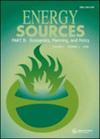Drivers and critical paths of carbon emissions in India: a structural path decomposition analysis
IF 3.1
4区 工程技术
Q3 ENERGY & FUELS
Energy Sources Part B-Economics Planning and Policy
Pub Date : 2022-12-31
DOI:10.1080/15567249.2022.2084185
引用次数: 5
Abstract
ABSTRACT As a fast-growing economy with over 1.35 billion people, India will be critical to achieving future climate targets. The country implemented many policies to limit its carbon emissions. To make targeted policies, it is imperative to evaluate the mutually opposing effects of fast development and climate policies on carbon emissions. We apply environmentally extended input-output analysis, and structural path and decomposition analysis to calculate key emission statistics and drivers of change in critical sectors and production paths. Results reveal that India is a net exporter of emissions and its production and consumption-based emissions have more than doubled between 2000 and 2016. Two sectors, ‘Electricity, gas, and water’ and ‘petroleum, chemical, and non-metallic mineral products,’ function as supplying sectors in most of the critical paths. Although improvements in emission intensity and production structure have helped in reducing emissions, household consumption and investments have increased them.印度碳排放的驱动因素和关键路径:结构路径分解分析
作为一个拥有13.5亿人口的快速增长经济体,印度对实现未来气候目标至关重要。这个国家实施了许多限制碳排放的政策。为了制定有针对性的政策,必须评估快速发展和气候政策对碳排放的相互对立的影响。我们应用环境扩展的投入产出分析、结构路径和分解分析来计算关键部门和生产路径的关键排放统计数据和变化驱动因素。结果显示,印度是排放净出口国,其生产和消费的排放量在2000年至2016年期间增加了一倍以上。“电力、天然气和水”和“石油、化工和非金属矿产品”这两个部门在大多数关键路径上起着供应部门的作用。虽然排放强度和生产结构的改善有助于减少排放,但家庭消费和投资却增加了排放。
本文章由计算机程序翻译,如有差异,请以英文原文为准。
求助全文
约1分钟内获得全文
求助全文
来源期刊

Energy Sources Part B-Economics Planning and Policy
ENERGY & FUELS-
CiteScore
6.80
自引率
12.80%
发文量
42
审稿时长
6-12 weeks
期刊介绍:
12 issues per year
Abstracted and/or indexed in: Applied Science & Technology Index; API Abstracts/Literature; Automatic Subject Index Citation; BIOSIS Previews; Cabell’s Directory of Publishing Opportunities in Economics and Finance; Chemical Abstracts; CSA Aquatic Science & Fisheries Abstracts; CSA Environmental Sciences & Pollution Management Database; CSA Pollution Abstracts; Current Contents/Engineering, Technology & Applied Sciences; Directory of Industry Data Sources; Economic Abstracts; Electrical and Electronics Abstracts; Energy Information Abstracts; Energy Research Abstracts; Engineering Index Monthly; Environmental Abstracts; Environmental Periodicals Bibliography (EPB); International Abstracts in Operations Research; Operations/Research/Management Science Abstracts; Petroleum Abstracts; Physikalische Berichte; and Science Citation Index.
Taylor & Francis make every effort to ensure the accuracy of all the information (the "Content") contained in our publications. However, Taylor & Francis, our agents, and our licensors make no representations or warranties whatsoever as to the accuracy, completeness, or suitability for any purpose of the Content. Any opinions and views expressed in this publication are the opinions and views of the authors, and are not the views of or endorsed by Taylor & Francis. The accuracy of the Content should not be relied upon and should be independently verified with primary sources of information. Taylor & Francis shall not be liable for any losses, actions, claims, proceedings, demands, costs, expenses, damages, and other liabilities whatsoever or howsoever caused arising directly or indirectly in connection with, in relation to, or arising out of the use of the Content. Terms & Conditions of access and use can be found at http://www.tandfonline.com/page/terms-and-conditions .
 求助内容:
求助内容: 应助结果提醒方式:
应助结果提醒方式:


